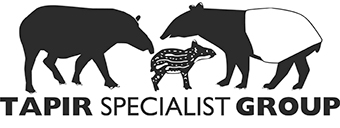
About the Tapir Specialist Group
The Tapir Specialist Group is a unit of the IUCN Species Survival Commission. We conserve biological diversity by stimulating, developing, and executing practical programs to study, save, restore, and manage the four species of tapir and their remaining habitats in Central and South America and Southeast Asia.
Our strategies:
a.) Frequent review, status determination and publicizing of tapirs and their needs
b.) Promoting and supporting research and distributing materials
c.) Promoting the implementation of conservation and management programs by appropriate organizations and governments
d.) Establishing strong and effective relationships among tapir conservationists to stimulate communication and cooperation
Tapir Specialist Group and Its Partners
The IUCN/SSC Tapir Specialist Group (TSG) is a scientific organization founded in 1980 as one of the 120 Specialist Groups of the International Union for the Conservation of Nature (IUCN) Species Survival Commission (SSC).
The TSG and the Association of Zoos and Aquariums (AZA) Tapir Taxon Advisory Group (TAG), the main organizers of the Second International Tapir Symposium, together with the European Association of Zoos and Aquaria (EAZA) Tapir Taxon Advisory Group (TAG) and the Tapir Preservation Fund (TPF), are the key groups working on developing and implementing tapir research, conservation and management programs. An important aspect of the mission of these four groups is to contribute to the development of a coordinated international conservation strategy for tapirs.
Who Is TSG?
TSG has over 140 members, including field researchers, educators, veterinarians, governmental agencies and NGO representatives, zoo personnel, university professors and students, from 28 countries worldwide (Argentina, Australia, Belize, Bolivia, Brazil, Canada, Colombia, Costa Rica, Denmark, Ecuador, Germany, Guatemala, Guyana, Honduras, Indonesia, Malaysia, Mexico, Panama, Peru, Taiwan, Thailand, The Netherlands, United Kingdom, United States, and Venezuela). All members are directly or indirectly involved in tapir field research and/or captive breeding in their respective regions. Over fifty percent of our members hail from developing countries.
TSG operates on a 100% volunteer basis. None of our members are paid by TSG for their tireless work on behalf of tapirs. In 2003 we established the Tapir Specialist Group Conservation Fund to raise funds to support the implementation of the recommendations of the IUCN/SSC Tapir Status Survey and Conservation Action Plan. The fund supports such activities such as creating educational and marketing materials for in-situ and ex-situ education initiatives, giving small grants to tapir researchers to sustain their projects, and supporting vital meetings such as the International Tapir Symposiums where tapir researchers can come together in person to share information, strategize and plan for tapir conservation.
Tapir Specialist Group Conservation Fund
To help fund our work, please consider donating to our Conservation Fund.
Find out more about donating to the Tapir Specialist Group
International Tapir Symposium – A Vital Connection Among Tapir Researchers
The First International Tapir Symposium was held in November 2001, in Costa Rica, and attracted 95 participants from 22 countries, proving to be a major boost for tapir conservation. Never before has there been so many tapir experts and conservationists, key players in the development of tapir conservation programs, assembled under one roof to share knowledge and address the challenges ahead for tapir species. Specific topics discussed during the First Symposium were field research, veterinary issues, population management, husbandry, fundraising, marketing, education, and tapir bio-politics.
At the First Symposium, we developed a list of goals and actions for the future, related to the structure of the TSG, communication, fundraising, and the urgent need to review the first edition of the IUCN/SSC Tapir Status Survey and Conservation Action Plan (1997). Several different task forces were formed and assigned specific responsibilities, and since then, the TSG has been growing stronger and improving its structure and effectiveness in many different ways.
[custom-facebook-feed num=5]
